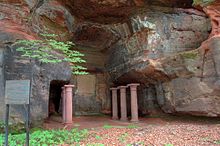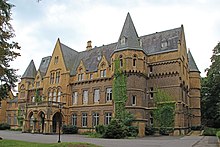Halberg (Saarland)
| Halberg | ||
|---|---|---|
|
View of the Halberg with the Osthafen in the foreground. |
||
| height | 280 m above sea level NN | |
| location | Saarland , Germany | |
| Coordinates | 49 ° 13 '21 " N , 7 ° 1' 56" E | |
|
|
||
The Halberg is 280 m above sea level. NN a solitary, wooded mountain in Saarbrücken . The Halberg rises in the Saaraue, which it towers over by about 80 m. The middle red sandstone stands on the slope and the upper red sandstone on the summit .
history
Roman time

In pre-Christian and Roman times, a Mithras cult was practiced on the Halberg by the Gallo- Romans who lived here or the Roman soldiers of the nearby garrison . To this end, they created a barrel-vaulted mithraium in the sandstone on the western slope of the Halberg , which in older literature is called "Heidenkapelle". After Christianization in the 6th century, the grotto was included in the Christian cult. Thus the Halberg is possibly the oldest Christian place of worship in the region. The remains of this site can still be admired here and are in relatively good condition.
18th century

On the top of the Halberg, Count Ludwig Kraft of Nassau-Saarbrücken built the baroque pleasure palace “Monplaisir” from 1709–1711 (with the motto: “Je veux que mon plaisir soit le plaisir de tous” (German: “I want that mine Pleasure becomes everyone's pleasure ”)). The then unwooded Halberg allowed a beautiful view of the Saar cities. In 1755 the complex was enlarged and redesigned by Friedrich Joachim Stengel, creating a princely zoo and a vineyard. In an expansion in 1772, the Mithras sanctuary was also integrated into the garden landscape and designed with columns. Princess Wilhelmine, whose marriage to Prince Ludwig von Nassau-Saarbrücken was broken, chose the castle as her refuge and raised her son, Hereditary Prince Heinrich von Nassau-Saarbrücken . The facility was completely destroyed on November 17, 1793 in the turmoil of the First Coalition War. Prince Heinrich, who had fled and died in exile, stipulated in his will that he wanted to be buried at the place of his happy childhood, which was not to be fulfilled until 1976.
19th century

From 1875, the wealthy mining entrepreneur acquired Carl Ferdinand Stumm (ennobled in 1888 as Baron von Stumm-Halberg) the grounds and was from 1877 to 1880 there competing with his brothers built the equally magnificent castles, a neo-gothic castle designed by the Hanover architect Edwin Oppler built . The Frankfurt garden architect Heinrich Siesmayer redesigned the surrounding landscape park . As a guest of Baron von Stumm-Halberg was staying in 1892 Kaiser Wilhelm II. On Schloss Halberg .
20th century
In 1936 there were plans to demolish the castle for a residential area, but these were never implemented. In 1939 the new Reichsender Saarbrücken moved into the complex. From 1946 to 1952, the French Governor General Gilbert Grandval resided in the palace before moving into the new building for the French Embassy on the banks of the Saar in Saarbrücken (today's Ministry of Culture). During this time, massive interventions were unfortunately made in the splendid historicist building, which was further damaged by a fire in 1958.
Halberg has been the seat of the Saarland Broadcasting Corporation since 1959 , with Halberg Castle (next to a restaurant) accommodating the SR's directorship . The associated radio station Halberg, the television building and the other buildings of the SR were built in 1958/1959 in the immediate vicinity of the castle. T. other outbuildings of the old castle were demolished. The park is now a parking lot. The studio complex also includes an 84-meter-high guyed tubular steel mast. Furthermore, the Institute for European Media Law eV (EMR) has been located on the Halberg since 2006 .
Halberg position
The Halberg position was part of the west wall . The position begins on the Brebacher Landstrasse and stretches along the mountain to the rear piston wood. With 19 intact bunker structures, the position is the only completely preserved Siegfried Line position in Germany.
From November 1939 soldiers of the 75th Infantry Division moved into the completed bunkers . This occupancy lasted until the beginning of June 1940. Except for a few artillery fire, there was no fighting in the vicinity of the Halberg. The construction work had not yet been completed when the news of the armistice with France arrived on June 22, 1940. In the late summer of 1940, the bunkers were disarmed and placed in the care of a wall foreman, who was supposed to constantly check the structures and carry out minor maintenance work. From 1942 the bunkers were released for air defense purposes. The residents of Brebach and the workers at the Halberger Hütte were given green ID cards that gave them a bunker as a refuge in the event of an air raid alarm.
When the front moved rapidly towards the Reich border in 1944, the Halberg position was reinforced by double ring stands between the existing installations. They were created to eliminate blind spots, served as observation posts and open combat positions for MG 42s and bazookas . A double ring stand restored by the “Fördergruppe WH 316” can be found on the WH 316 structure. From October 1944 onwards, the remaining population of Saarbrücken created an extensive system of trenches on Halberg in "Schanzarbeit". Several anti-tank trenches were also dug; they were supposed to prevent enemy tanks from getting into the rear of the fortification line.
Due to the development in weapon technology, many modern weapons did not fit into the bunkers from 1939. Extensive conversions or new buildings could no longer be carried out, many systems were misappropriated, looted and therefore unusable.
On January 25, 1945, the Westwall in Saarbrücken was occupied by the 347th Volksgrenadier Division. The WH 316 bunker served as a company command post and was occupied from January 1, 1945 until the night of March 19 to 20, 1945. That night, because of the advance of the 7th US Army, the remaining German troops were ordered to retreat towards the Rhine. No fighting took place in the Halberg position.
On March 20, US troops entered Saarbrücken. They inspected the west wall closely; many soldiers used the bunker as a backdrop for winning photos.
In July 1945, the US troops were replaced by French units. The military governor (1945–48) and high commissioner (1948–52) for the Saarland, Colonel Gilbert Hirsch-Ollendorf alias Grandval , moved into Halberg Castle around 1946. While he was residing in the castle, the Saar battalion took care of his safety.
The Siegfried Line at Halberg was used as a warehouse for ammunition and weapons. It is thanks to this fact that none of the installations was blown up. However, the buildings were later stripped of their inventory. What the French had left behind was removed from the area by scrap dealers in the following years. It was not until the 1970s that the bunkers were walled up by what was then the Federal Property Office and later partially covered with earth.
The former company command post WH 316 was restored by the support group Bunker WH 316 eV and can now be viewed as a museum.
Others
The Stumm family cemetery on the access road to Halberg was desecrated at the end of the 20th century and all cast-iron grave crosses were stolen. In 2004 the cemetery was renovated.
The Halbergerhütte was named after the Halberg and after this the Halberg-Guss GmbH, which was separated from the Halbergerhütte in 1988 and has its premises at the foot of the mountain.
The mountain was the venue of the nationally known, annual school holiday festival Halberg Open Air .
literature
- Joachim Conrad, Stefan Flesch: Castles and palaces on the Saar. 3rd edition, Saarbrücken 1993, ISBN 3-477-00078-1 .
- Dieter R. Bettinger et al .: The Westwall from Kleve to Basel. On the trail of German history. Podzun-Pallas publishing house, Eggolsheim 2002, ISBN 978-3-7909-0754-4 .
- Jörg Fuhrmeister: The Siegfried Line, past and present. 2nd edition 2004, ISBN 3-613-02291-5
- Jörg Fuhrmeister: The Halberg position, a piece of Westwall history in Saarbrücken. Self-published, Blieskastel 2009.
- Doris Seck : Westwall Company, ISBN 3-922807-05-4
- Doris Seck: The zero hour, ISBN 3-922807-34-8
- Doris Seck: Post-war years on the Saar, ISBN 3-922807-17-8
Web links
- Literature about Halberg (Saarland) in the Saarland Bibliography
- Homepage of the Saarland Broadcasting Corporation
- Information about the Mithras grotto
- Information from the funding group Bunker WH 316
Individual evidence
- ^ Geological map of the Saarland , scale 1: 50000. Ed .: Geological State Office of Saarland, Saarbrücken 1981
- ↑ Gilbert Grandval at www.saar-nostalgie.de
- ↑ Threatened witness the Saar history . Saarbrücker Zeitung , local section of December 23, 2004. Online archive of the Saarbrücker Zeitung.



